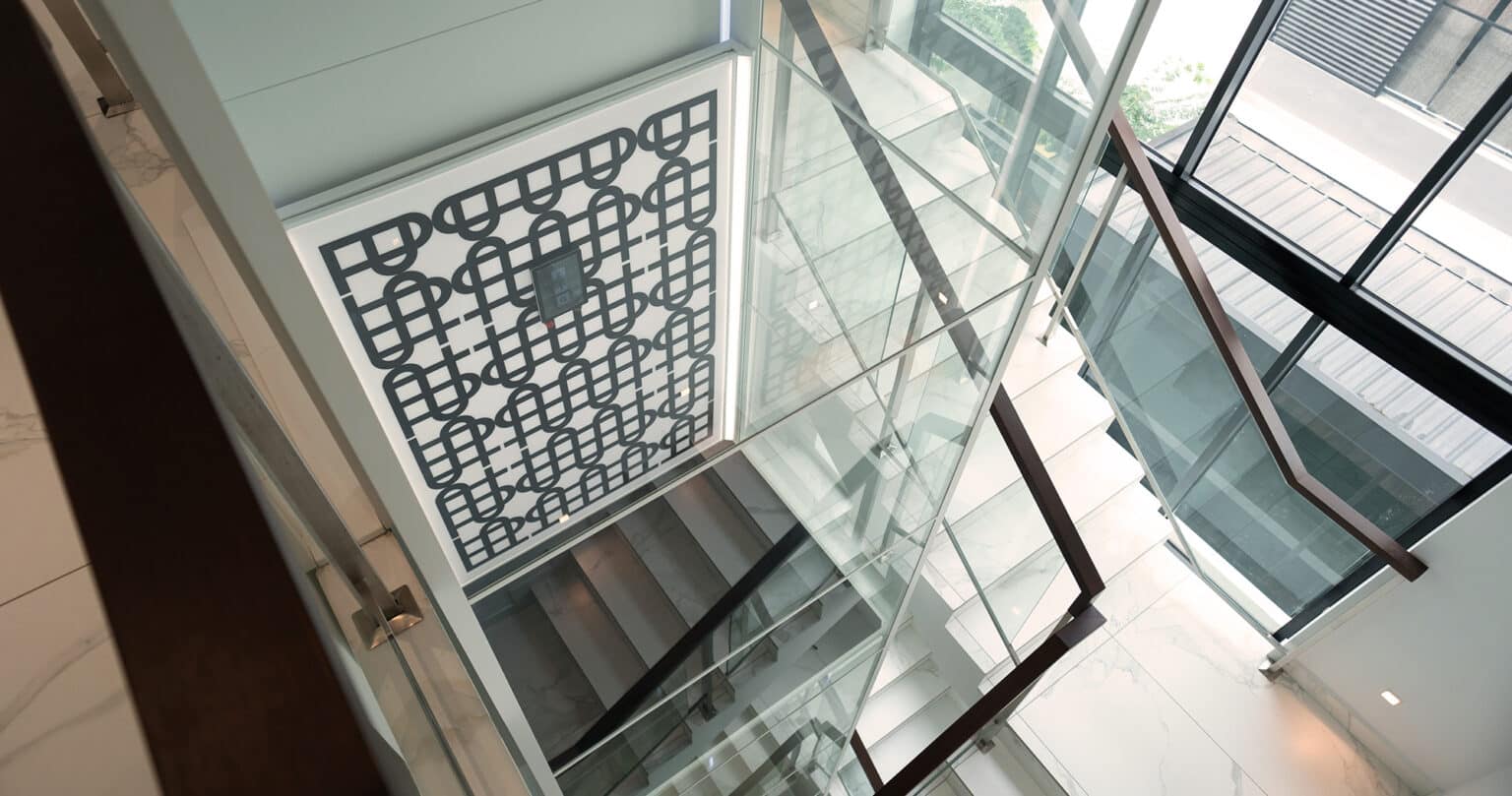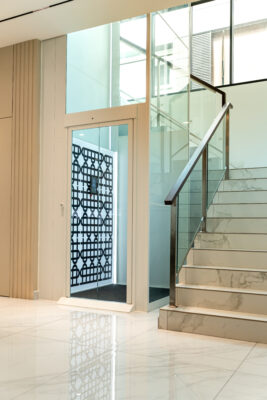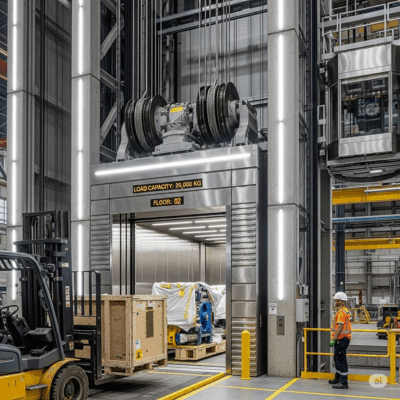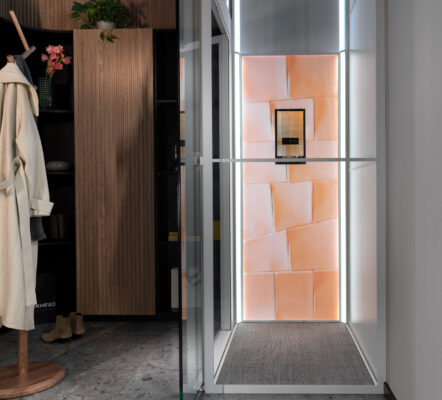
According to a report, Indian elevator market size is expected to reach USD 4.84 billion by 2030, growing at a CAGR of 7.8% from 2025 to 2030. As modern homes evolve to prioritize comfort, accessibility, and style, installing a domestic elevator is no longer just a luxury; it’s a practical solution for multi-story living. With advancements in technology and a variety of elevator types available, homeowners now have access to solutions that can be customized to fit different architectural designs, budgets, and specific mobility needs.
This blog will walk you through everything you need to know about domestic elevator lift for home, including:
6 Types of Residential Elevators
#1 100% Battery driven
Battery-driven elevators function with a 48V battery bank and a patented EcoDrive system, powered through downward travel, a battery charger, or optional solar panels. Using just 900W of single-phase power, they offer a highly efficient and quiet operation, ideal for low- to mid-rise homes where energy savings and comfort are key. Their customizable design makes them a perfect fit for modern residences.

Key features:
- Machine-room-less, installs directly on the floor with 230V single-phase power
- Adjustable lift and door speeds for different users (e.g., children, visitors, elderly)
- 10 years warranty on screw and nut drive system, 5 years on the lift (with Support and Maintenance package)
- Remote monitoring to optimize functionality and reduce maintenance costs (Option)
- Intuitive interface for floor naming and user profile settings
- Full operation during power failures for safety
- Over 90% of components are recyclable
- 20% faster start time than comparable systems with Thor Engineering™ system
- Patent-pending screw and nut system for minimal maintenance
- Meets European Machinery Directive 2006/42/EC safety standards.
#2 Hydraulic Elevators
Hydraulic elevators operate using a piston that moves inside a cylinder, powered by hydraulic fluid pressure. They provide a smooth and quiet ride, making them ideal for low- to mid-rise homes where comfort is a priority. Their ability to handle heavy loads makes them suitable for villas and duplexes.
Key features:
- Machine room and pit required
- High weight capacity, suitable for heavy loads
- Moderate speed, best for fewer floors
- Less energy-efficient compared to traction systems
Limitations of Hydraulic Lifts:
- Require a machine room and a pit, which increases installation complexity, space needs, and cost.
- Hydraulic systems consume more power, especially because the pump motor runs during each trip and hydraulic fluid has losses, leading to higher operating costs compared to traction elevators.
- Slower speed, generally moderate, making them less suitable for high-rise buildings or locations needing fast vertical transport.
- Potential for hydraulic fluid leaks, which can lead to environmental concerns and costly maintenance.
- Regular maintenance requirements, particularly for the hydraulic pump, seals, and fluid replacement, increasing lifetime costs.
- Limited to low- to mid-rise applications typically up to 5-6 floors; not scalable for taller buildings due to rising cylinder and fluid volume needs.
- Possible overheating of hydraulic fluid in frequent or high-usage situations, which can degrade performance or damage components.
#3 Traction Elevators
Traction elevators use ropes and counterweights driven by an electric motor, similar to commercial elevators. The cable-driven system, combined with counterweights, enables traction elevators to handle heavy loads efficiently and safely. This makes them ideal not only for residential use, such as moving furniture or groceries, but also for commercial buildings, shopping centers, and industrial facilities where transporting heavy items is common.

Key features:
- Machine room required (except MRL)
- High speed and capacity
- Energy-efficient operation
- Suitable for multi-floor homes
Limitations of Traction Lifts:
- Higher initial installation cost compared to hydraulic and simpler elevator types due to complex components like ropes, counterweights, and motors.
- Require a machine room in traditional models, which increases space demands and building design constraints (though machine-room-less options exist but may be costlier).
- Complex installation requiring specialized expertise and longer setup time.
- Maintenance complexity and cost are higher due to intricate mechanical components needing regular inspection and servicing.
- Dependence on electricity makes them inoperable during power outages unless backup systems are installed.
- Noise levels can be higher, especially at high speeds, potentially affecting comfort in quiet environments.
- Building-specific structural requirements, including overhead space and pit dimensions, which may be restrictive or costly to implement in existing buildings.
- Larger spatial requirements than some alternatives, due to need for motor, counterweight, and shaft components.
#4 Pneumatic (vacuum) elevators
Pneumatic (vacuum) elevators work by creating a vacuum above the car inside a transparent tube, moving it via air pressure. These elevators are small elevators for homes, space-efficient and offer a modern look but have a limited weight capacity, usually accommodating only two passengers. Beyond their sleek design and ease of installation, pneumatic elevators are equipped with advanced safety features such as mechanical safety brakes that engage automatically if vacuum loss is detected, and car locks that securely anchor the cabin at each floor to ensure precise leveling and safe entry and exit.

Key features:
- No machine room or pit required
- Limited to 1-2 passengers
- Quiet and energy-efficient
- Minimal structural changes needed
Limitations of Pneumatic Lifts:
- Generally suitable only for low-rise buildings, typically up to about 3-4 floors, making them unsuitable for taller structures.
- Usually accommodate only 1-2 passengers with limited payload, which restricts use for heavy loads or wheelchair accessibility.
- Installation can be expensive, particularly in retrofit situations or where building modifications are needed.
- Their vertical travel speed is slower than traditional or traction elevators, resulting in longer ride times.
- Although no machine room or pit is needed, the large cylindrical tube requires sufficient vertical and horizontal space, which may be challenging in cramped areas.
- Some models can generate noticeable noise during operation, which might be a disturbance in quiet home environments.
- Typically only one door per floor, which can limit convenience depending on floor layouts.
- Transparent or semi-transparent tubes mean less privacy compared to enclosed traditional elevators.
- While maintenance is generally minimal, the vacuum system requires regular checks, and certain components may wear over time. This increases the overall 2 person lift price in India.
#5 Winding Drum Elevators
Winding drum elevators use an electric motor to wind the hoisting cable onto a drum to raise and lower the elevator car. They do not use counterweights, and save space within the shaft, allowing for slightly larger cabin dimensions and increased load capacity relative to the shaft size. These elevators generally have moderate capacity and speed.
Key features:
- Machine room and pit required
- Moderate capacity (typically 500-750 lbs)
- Reliable and simple mechanical design
- Suitable for low- to mid-rise residential buildings
Limitations of Winding Drum Lifts:
- Require a machine room, pit, and shaft, which can make installation complex and space-consuming, often unsuitable for retrofit projects in existing homes.
- They tend to produce more noise and a rougher ride compared to other elevator types, which can affect user comfort.
- Typically capped at moderate speeds (around 30-40 feet per minute) and limited load capacity (generally 500-750 lbs), making them less suitable for heavier or faster requirements.
- Steel cables can stretch over time and typically require replacement every 3 to 5 years depending on usage, adding to maintenance of home lift prices.
- Requires significant structural modifications (pit, shaft, machine room) which can reduce living or storage space and increase costs.
- The motor and winding drum’s location can affect ease of maintenance, especially if installed laterally rather than above the shaft.
- The mechanical winding action tends to be less refined, producing noticeable clicks from brake engagement at stops.
- While more efficient than hydraulic elevators, winding drum systems are generally less energy efficient compared to traction elevators with counterweights.
#6 Shaftless Elevators
Shaftless elevators are a space-saving solution designed to operate between two floors without requiring a traditional shaft, machine room, or pit. They often feature integrated sliding doors and a compact footprint, making them ideal for retrofit projects or homes with limited space. These elevators provide smooth and reliable vertical transport, improving accessibility for elderly or mobility-impaired residents.
Key features:
- No shaft, machine room, or pit required
- Compact footprint, ideal for retrofit or new builds
- Typically limited to two floors
- Enhanced safety with hold-to-run operation
Limitations of Shaftless Lifts:
- Typically limited to travel between only two floors, restricting their use in multi-story buildings.
- Lower weight capacity compared to traditional shaft elevators, which may limit passenger and load size.
- Slower speeds and fewer options for customization compared to conventional elevators.
- Require sufficient structural support in the building between floors for safe installation.
- Not suitable for buildings with complex layouts or where floor-to-floor structural conditions don’t accommodate shaftless designs.
- Limited door configurations, often with integrated sliding doors that may not fit all architectural styles.
- Less suitable for very frequent or heavy use due to design and mechanical constraints.
- May have a higher upfront house lift price compared to basic stairlifts or platform lifts despite space savings.
Cost factors & price breakdown for Residential Elevators
| Elevator Type | Approximate Price Range (INR) | Typical Installation & Additional Costs | Annual Maintenance Cost (INR) |
| 100% battery Driven / Screw and Drive |
₹15 lakh – ₹28 lakh | Installation ₹3-6 lakh; no pit or machine room required; optional solar panel integration may add to cost | 3% of Lift Cost |
| Screw and Drive | ₹20 lakh – ₹45 lakh | Installation ₹3-6 lakh; no pit or machine room required; optional solar panel integration may add to cost | 3% of Lift Cost |
| Hydraulic Elevators | ₹10 lakh – ₹20 lakh | Installation ₹3-8 lakh; Pit & machine room construction adds to cost | 3% of Lift Cost |
| Traction Elevators | ₹12 lakh – ₹18 lakh | Installation ₹4-10 lakh; MRL variants reduce machine room cost |
3% of Lift Cost |
| Pneumatic (Vacuum) Elevators | ₹11 lakh – ₹25 lakh | Lower installation cost due to no pit or machine room; typically ₹2-5 lakh |
3% of Lift Cost |
| Winding Drum Elevators | ₹10 lakh – ₹25 lakh | Installation ₹3-7 lakh; shaft and pit construction costs apply | ₹25,000 – ₹1,00,000 |
| Shaftless Elevators | ₹12 lakh – ₹20 lakh | Installation ₹2-4 lakh; minimal structural changes needed |
3% of Lift Cost |
Legal and Regulatory Considerations for Residential Lifts in India
1. Key Permits and Approvals
- Lift License Requirement:
Before installing, operating, or maintaining a home elevator lift, most Indian states mandate a lift license. This involves securing both a “licence to erect” (for installation) and a “licence to operate” (for use), issued by the state’s designated authority (often the Electrical Inspectorate or Lift Inspector). - Application Process:
Applicants must submit a detailed application, including technical drawings, building plans, and proof of compliance with Indian Standards (IS 14665, IS 15259). Application and inspection fees are payable as part of the process. - State-Specific Rules:
States such as Maharashtra, Gujarat, Karnataka, Tamil Nadu, Delhi, Kerala, Haryana, West Bengal, Assam, and Himachal Pradesh have their own Lift Acts. In other states, local building bye-laws govern compliance.
2. Safety Norms and Standards
- IS 14665: Governs the design, installation, safety devices, inspection, and maintenance for electric lifts, ensuring robust safety and operational protocols.
- IS 15259: Specifies installation and maintenance standards for home lifts, including load capacity (204–272 kg) and speed limits (≤0.2 m/s).
- National Building Code (NBC) 2016:
Mandates structural requirements for lift shafts (load-bearing, fire resistance), and requires lifts to be accessible to all users, including persons with disabilities.
- Mandatory Safety Features:
- Emergency two-way communication systems
- Automatic Rescue Device (ARD) for safe descent during power failure
- Door interlocks and sensors
- Overload protection and emergency alarms
- Fireman’s mode and fire safety compliance
3. Installation and Inspection
- Certified Contractors:
Only certified and licensed contractors may install and maintain lifts. Installations must follow approved technical drawings and BIS standards. - Post-Installation Testing:
Statutory safety checks and load testing are mandatory. State authorities inspect the installation before commissioning the lift for use. A commissioning certificate is issued upon successful inspection.
4. Maintenance and Ongoing Compliance
- Annual Maintenance Contract (AMC):
Engaging a qualified service provider for regular maintenance of your domestic lift is compulsory. Routine inspections and timely renewal of the operating license are required. - Owner/Association Responsibility:
The building owner or Residents’ Welfare Association (RWA) is legally responsible for ensuring lift safety, ongoing maintenance, and regulatory compliance. Non-compliance can lead to penalties or lift shutdown.
5. Accessibility and Design
- Accessibility Laws:
Home lifts must be universally accessible, meeting the Rights of Persons with Disabilities Act. This includes sufficient platform space, wide doors, and user-friendly controls. - Minimum Specifications:
- Platform size: at least 9 sq ft (approx. 3×3 ft)
- Load capacity: 204–272 kg (3–4 persons)
- Speed: Not exceeding 0.2 m/s for home lifts
- Design Considerations:
Lifts should feature accessible control panels (with Braille and visual indicators), appropriate lighting, and clear signage to support all users, including those with disabilities.
This framework ensures that residential lifts in India are installed, operated, and maintained to the highest standards of safety, accessibility, and legal compliance.
Wrapping Up
Elevators are no longer reserved for the privileged few; they are becoming integral to inclusive, multigenerational living and thoughtful design.
The true value of a elevator lift for home lies not just in its ability to bridge floors, but in its power to bridge generations, abilities, and lifestyles. Whether you’re planning for aging in place, welcoming guests of all ages, or simply future-proofing your home, connect with SwiftLifts to transform the way you live—quietly, safely, and elegantly.
So as you weigh your options, consider not just the specifications or the home elevator prices, but the possibilities: How might an elevator change the way your family connects? How might it open your home to new experiences, new memories, and new beginnings?
Get In Touch!










